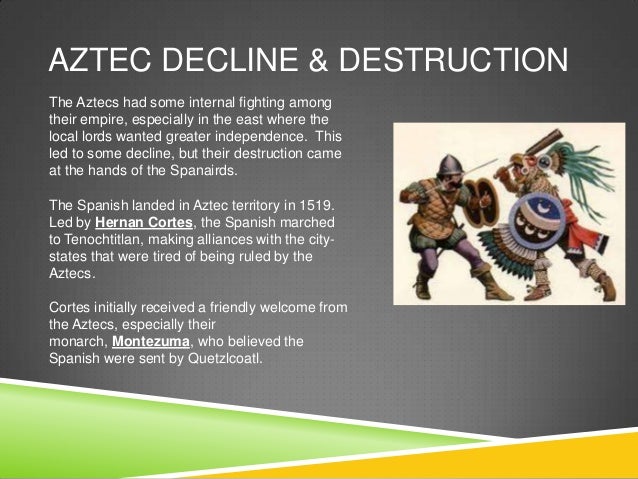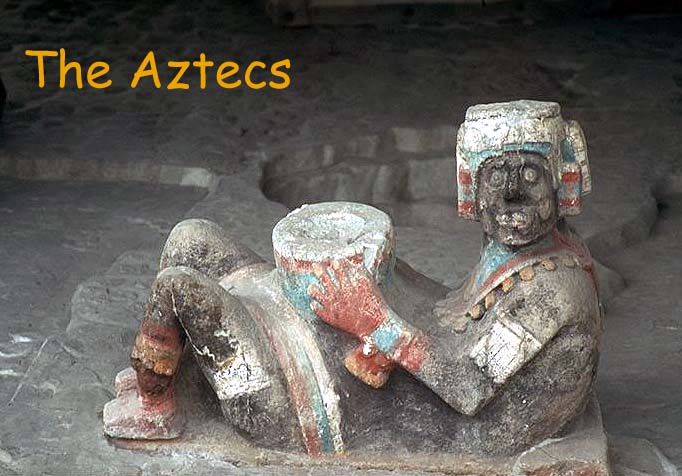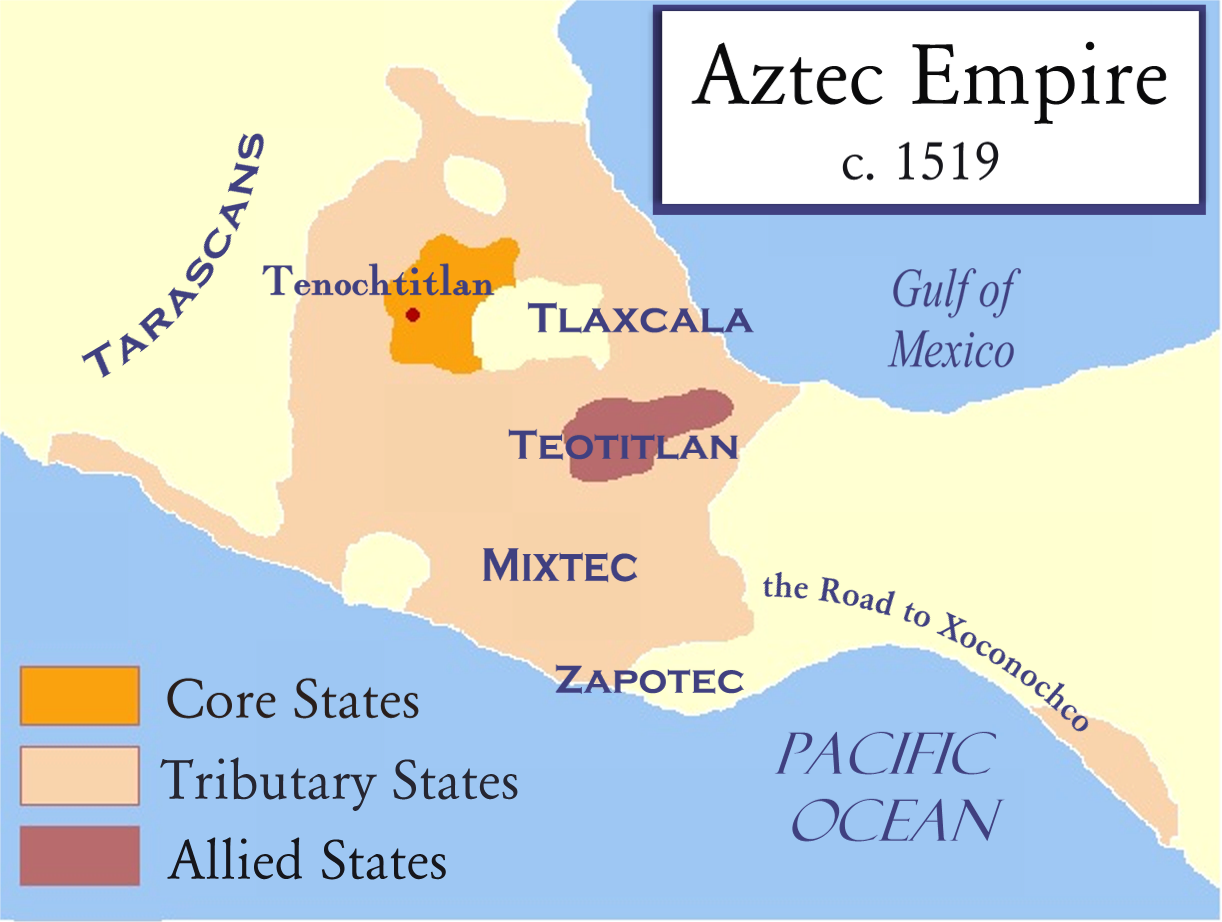Introduction
While the Maya were developing their civilization to the south, other high cultures were evolving in central Mexico. Some of the most important developments took place in and around the Valley of Mexico. This valley, where modern Mexico City is located, eventually became the site of the
greatest empire of Mesoamerica, the Aztec.Before the setting up of the aztec empire, the first major civilization of central Mexico was Teotihuacán, a city-state whose ruins lie just outside Mexico City. it had a very large population making it the largest cities at that time.
After the fall of Teotihuacán, no single culture dominated central Mexico for decades. Then, around 900, a new people, the Toltecs, rose to power. For the next three centuries, the Toltecs ruled over the heart of Mexico from their capital at Tula.
The Aztec Empire
The Aztecs arrived in the Valley of Mexico around A.D. 1200. The valley contained a number of small city-states that had survived the collapse of Toltec rule. The Aztecs, who were then called the Mexica, were a poor, nomadic people from the harsh deserts of northern Mexico. Fierce and ambitious, they soon adapted to local ways, finding work as soldiers-for-hire to local rulers.
According to one of the Aztec legends, the god of the sun and warfare, Huitzilopochtli (wee•tsee•loh•POHCH•tlee), told them to found a city of their own. He said to look for a place where an eagle perched on a cactus, holding a snake in its mouth. These words capture part of the legend:
The place where the eagle screams,
where he spreads his wings;
the place where he feeds,
where the fish jump,
where the serpents
coil up and hiss!
This shall be Mexico Tenochtitlán
and many things shall happen!
They found such a place on a small island in Lake Texcoco, at the center of the valley. There, in 1325, they founded their city, which they named Tenochtitlán.
Aztecs Grow Stronger
over the years the aztecs grea in number and strength. in 1428 they joined with two other city states- Texcoco and Tlacopan- to form Triple Alliance. This alliance became the leading power in the Valley of Mexico and soon gained control over neighboring regions. By the early 1500s, the alliance controlled a vast empire that covered some 80,000 square miles stretching from central Mexico to the Atlantic and Pacific coasts and south into Oaxaca. This empire was divided into 38 provinces. It had an estimated population of between 5 and 15 million people.
The aztecs exercised loose control over the empire often letting local rulers govern their own region.they did demand tribute from the rulers in the form of gold,cotton , jade etc.If local rulers failed to pay tribute, or offered any other kind of resistance, the Aztecs responded brutally. They destroyed the rebellious villages and captured or slaughtered the inhabitants.
Nobles rule Aztec society military leaders held great power in Aztec society. Along with government officials and priests, these military leaders made up the noble class. There were two other broad classes in Aztec society, commoners and enslaved persons. Commoners included merchants, artisans, soldiers, and farmers who owned their own land. The merchants formed a special type of elite. They often traveled widely, acting as spies for the emperor and gaining great wealth for themselves. The lowest class, enslaved persons, were captives who did many different jobs.

Tenochtitlán: A Planned City

planned city of tenochtitlan
By the early 1500s, Tenochtitlán had become an extraordinary urban center. With
a population of between 200,000 and 400,000 people, it was larger than London or any other European capital of the time. Tenochtitlán remained on its original island site. To connect the island to the mainland, Aztec engineers built three raised roads, called causeways, over the water and marshland. Streets and broad avenues connected the city center with outlying residential districts. The canals that intersected with these roadways allowed canoes to bring people directly into the city center. Canoes also brought goods from the farthest reaches of the empire to the economic heart of the city, the huge market of Tlatelolco . Visitors to the market also found a great deal of local agricultural produce on display, including avocados, beans, chili peppers, corn, squash, and tomatoes. Most of the fruits and vegetables sold at the market were grown on chinampas, farm plots built on the marshy fringes of the lake. These plots, sometimes called “floating gardens,” were extremely productive, providing the food needed for a huge urban population.
At the center of the city was a massive, walled complex, filled with palaces, temples, and government buildings. The main structure in the complex was the Great Temple. This giant pyramid with twin temples at the top, one dedicated to the sun god and the other to the rain god, served as the center of Aztec religious life.
 the great temple of tenochtitlan
the great temple of tenochtitlan
The Art of the Aztec Civilisation
The people of the empire had an appreciation for a wide variety of insects, birds, fish and animals. A lot of their art reflected this. Jaguars, ducks, monkeys, snakes, deer, dogs - all these were common themes.The gods were often depicted, and they themselves often resembled animals of various kinds. The drawings of the gods were often sharp and angular, brightly coloured. Art would often show gods, or priests dressed as gods in a ritual, or Aztec warriors in their finery.
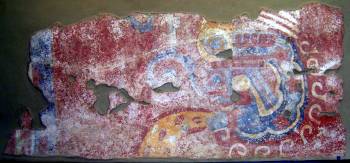 Fresco of a snake, Aztec art from Teotihuacan
Fresco of a snake, Aztec art from Teotihuacan
Mosaics are very common in ancient Aztec art. Masks would be covered in turquoise, or
shells.There was a rich variety of art in the empire. Richly coloured clothing, architecture, ceremonial knives, head dresses - many things were adorned with jewels and feathers. It is said that the emperor never wore the same clothes twice. His head piece that supposedly belonged to Emperor Montezuma II is a splash of bright green feathers, embroidered with gold and blue. Noble families had ear pieces, bracelets and necklaces.
Statues made of stone, as well as Aztec masks, pottery, shields, knives, carved pillars and painted walls.
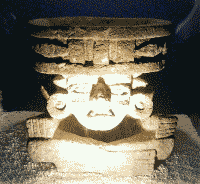
Characteristics
Ancient Aztec art was actually very lifelike. Many of their statues of people, as well as animals, look amazingly realistic. They also show age, and a great deal of expression. The art looks alive - but then again, much of it is about death itself. It again reflects the people's passion to avoid death and disaster, and then to conquer even that if it came.
 |
| Lowrider Arte Black And White Art Aztec Woman |
Religion Rules Aztec life
religion played an important role in the society.tenochtitlan had hundreds of temples and people worshipped 1,000 gods.the Aztecs worshiped the Toltec god Quetzalcoatl in many forms.They saw him as the god of learning and books, the god of the wind, and a symbol of death and rebirth. The
Aztecs pictured Quetzalcoatl not only as a feathered serpent, but also as a paleskinned man with a beard..
 this mural in the National Palace in Mexico city shows Quetzalcoatl in many forms.
this mural in the National Palace in Mexico city shows Quetzalcoatl in many forms.
Religious Practices
Aztec religious practices centered on elaborate public ceremonies designed to communicate with the gods and win their favor. At these ceremonies, priests made offerings to the gods and presented ritual dramas, songs, and dances featuring masked performers. The Aztec ceremonial calendar was full of religious festivals, which varied according to the god
being honored.
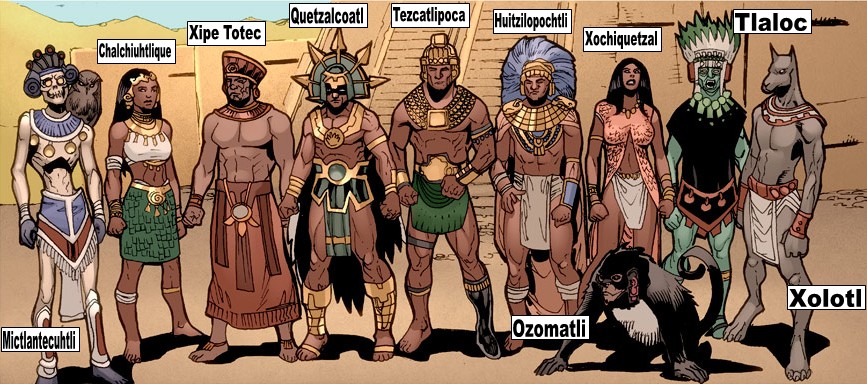
different gods worshipped by the aztec people
The Aztec Calendar
The Aztec system of tracking the days was very intricate.
Archaeologists believe that the Aztec calendar system was derived
from the Maya system. The Aztecs followed two main calendars: a
sacred one with 13 months of 20 days and an agricultural or solar
one with 18 months of 20 days. (Notice that this comes to 360 days.
The Aztecs then had an unlucky five-day period known as
nemontemi, making their solar calendar 365 days long.) Every 52
years, the two calendars would start on the same day, and a great
ceremony of fire marked the occasion.

Sacrifices for the Sun God
The most important rituals involved a sun god, Huitzilopochtli. According to Aztec belief, Huitzilopochtli made the sun rise every day. When the sun set, he had to battle the forces of evil to get to the next day. To make sure that he was strongenough for this ordeal, he needed the nourishment of human blood. Without regular offerings of human blood, Huitzilopochtli would be too weak to fight. The sun would not rise, the world
would be plunged into darkness, and all life would perish. For this reason, Aztec priests practiced human sacrifice on a massive scale. Each year, thousands of victims were led to the altar atop the Great Temple, where priests carved out their hearts using obsidian knives.
 sacrificial victims mainly included enslaved people,criminals and people offered as tribute by conquered province.
sacrificial victims mainly included enslaved people,criminals and people offered as tribute by conquered province.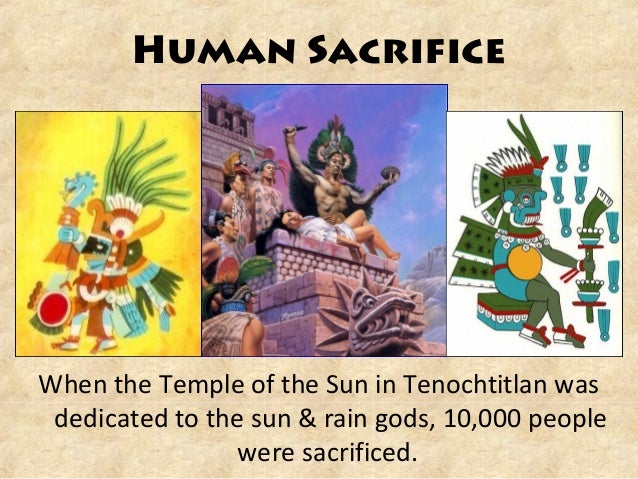
Aztec Sunstone
Originally located in the main ceremonial plaza of Tenochtitlán, the Aztec calendar stone measures 13 feet in diameter and weighs 24 tons. It was uncovered in Mexico City in 1790. The Sunstone, as it is called, contains a wealth of information about the days that began and ended the Aztec months, the gods associated with the days, and many other details.
Problems in the Aztec Empire-The Decline
In 1502, a new ruler, Montezuma II , was crowned emperor.Under Montezuma, the Aztec Empire began to weaken. For nearly a century, the Aztecs had been demanding tribute and sacrificial victims from the provinces under their control. Now, with the population of Tenochtitlán growing ever greater, Montezuma called for even more tribute and sacrifice. A number of provinces rose up against Aztec oppression. This began a period of unrest and rebellion, which the military struggled to put down.Over time, Montezuma tried to lessen the pressure on the provinces. For example, he reduced the demand for tribute payment by cutting the number of officials in the Aztec government. But resentment continued to grow. Many Aztecs began to predict that terrible things were about to happen. They saw bad omens in every unusual occurrence—lightning striking a temple in tenochtitlán, or a partial eclipse of the sun, for example. The most worrying event, however, was the arrival of the Spanish. For many Aztecs, these fair-skinned, bearded strangers from across the sea brought to mind the legend of the return of Quetzalcoatl.
